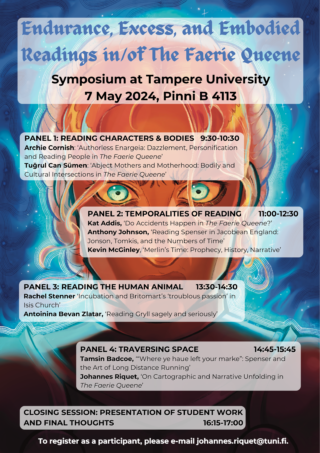In this three-day event – one of the world’s first of its kind (as far as we can tell, the first was held in Tampere in 2019) – we will jointly read Edmund Spenser’s epic poem The Faerie Queene (1590/1596) and embark on a wild ride through a world of knights, dragons and magical creatures.
We will thereby return poetry to its origins of being recited and enjoyed communally. On Friday morning, introductory lectures will introduce you to the literary, cultural and linguistic contexts of Spenser’s work and thereby prepare you for the reading. The reading itself will begin on Friday after lunch and end on Sunday evening.
Participants should bring a copy of The Faerie Queene to the event. Recommended edition: Penguin Classics. This year’s iteration of the marathon reading will be organised in partnership with the University of Zurich and the University of Bristol. In addition to students from Tampere University, the event will be attended by a group of students from Zurich as well as a group of Spenser scholars. The marathon reading will be followed by a one-day conference on the topic of ‘Endurance, Excess, and Embodied Readings in/of The Faerie Queene’. The notion of reading pervades The Faerie Queene, and it is frequently connected to perceptual, cognitive, and physical struggles. If the ‘ample volume’ that Guyon reads in Alma’s castle exceeds the narrator’s ‘leasure’, this functions as an allegory not only of the many journeys and quests in The Faerie Queene, but also of the reader’s passage through Spenser’s monumental work. As Patricia Parker noted long ago in Inescapable Romance, The Faerie Queene continually defers the end of its spatial and textual paths. This deferral implies a serial logic in which there is always more space to traverse and always more text to read. It is therefore not surprising that the poem repeatedly presents images of endurance and bodily exhaustion:
‘After long wayes and perilous paines endur’d, / Hauing their wearie limbes to perfect plight / Restord, and sory wounds right well recured . . .’ (3.1.1.2-4). The conference will explore the parallels between the characters’ physical struggles and the reader’s embodied experience of the text, discussing different forms of endurance, excess, and embodied reading in Spenser’s monumental work.
Learning objectives
Students familiarise themselves with Spenser’s The Faerie Queene in its entirety.
Additional information
Students wishing to earn 2 credit points are required to attend the entire marathon reading and submit a short, free-form report (2-3 pages) or creative response. Students wishing to earn 3 credit points are required to attend the entire marathon reading as well as the conference on 7 May and submit a short, free-form report (2-3 pages) or creative response.
For more information, contact johannes.riquet@tuni.fi


